by Winding Pathways | Apr 2, 2020 | (Sub)Urban Homesteading, Foraging, Garden/Yard
Our Yards Offer Nutrition
Every spring we look forward to eating delicious, free, wild greens that grow in our yard and just about every place people live. Having an ability to identify, pick, prepare, and eat wild foods gives us some comfort in this age of uncertainty.
We encourage everyone to boost their backyard food production through gardening, backyard chickens for those who can keep them, and foraging. Here are a few things to consider before picking and eating any wild plant.
- Make sure you’ve identified the plant correctly. Use two sources to confirm identification. These might be an expert forager and a book or Internet source or a combination.
- Make sure the plants have not been contaminated by pesticides, animal feces, or vehicle exhaust. It’s best to forage away from busy roads. Wash plants thoroughly before preparing.
- Eat just a small portion the first time. Although it might be fine food for most people there’s a chance you might be allergic to it.
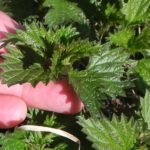
Carefully pluck the top three leaves off.
The key to enjoying all wild greens is to harvest them when they are very young. Many edible wild plants are tender and delicious shortly after they sprout but soon get coarse and bitter as warm weather stimulates their growth.
Nettles, sometimes called stinging nettles, live in moist places near streams, ponds, and woods, where they seem to prefer light shade. We have a couple of patches in our yard. They green up early in the spring, and we pick them before they are ten inches tall. We carefully pick just the top three or four small leaves. Remember these are stinging nettles. Wear light gloves or carefully pinch the top growth off the plant between the thumb and index finger. About a hundred leaf clusters make a great dish for the two of us. Rinse the nettles and boil them for a few minutes. The stinging part is a protein that dissolves in boiling water. We put a dab of butter on the drained cooked nettles and drink the water as a delicious spring tea.
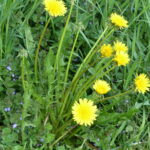
By mid-summer dandelion leaves are tough and bitter.
Because of herbicide companies’ promotions, just about everyone dislikes dandelions. Some have heard that dandelions are edible. It is true and, we need to thank our European ancestors for bringing dandelions to the New World. Otherwise, they might not have survived. They are high in vitamin A, folate, vitamin K, and vitamin C and a good source of calcium and potassium. Today, folks from Mediterranean countries grow and harvest dandelions as crops. They are a popular dish in Italian communities.
The few people who have tried eating them make the mistake of picking mature leaves in mid-summer. By that time, they are bitter and inedible. The best dandelion leaves are those picked in early spring and have been under a blanket of leaves. They’ll be partially blanched and delicious. It’s fine to pick small young leaves that can be added to salads if they are not too bitter. If they are bitter, boil two pots of water. Put the leaves in one pot and boil for a couple of minutes. Drain and put them in the second pot of boiling water and boil for another minute or so. The boiling removes the bitterness. Drain and enjoy with butter and salt and pepper.
This is a year of great anxiety and having some knowledge of how to find free food nearby can remove some of that concern.
by Winding Pathways | Nov 21, 2019 | (Sub)Urban Homesteading, Birds, Foraging, Garden/Yard, Nature, Trees
A New World Thanksgiving
Almost every meal Americans enjoy comes from animals and plants that trace their origin to many continents.
Cattle, sheep, chickens, and pigs, for example, are all natives of the Old World brought to America soon after it was settled by Europeans. Wheat, rice, and many other plant foods are also newcomers that were unknown to Native Americans.
One annual feast mostly made from original American foods is Thanksgiving. This year why not create this traditional feast from entirely plants and animals that were found here before Columbus?
Turkeys
Turkey highlights the Thanksgiving dinner. See our previous blog on this amazing and tasty bird. Here are plants native to North and South America to complement roast turkey:
Fruits and Vegetables
Corn: Corn has been grown in Central America for thousands of years. It’s cultivation gradually spread north and east and became a staple food for Native Americans. When hungry Pilgrims landed in what became Massachusetts they found and stole caches of corn stored by local tribes, no doubt causing bad feelings.
Cranberries: Most commonly eaten fruits originated in Europe or Asia, but the cranberry is an American native.
Squash and Pumpkins: Dozens of varieties of winter squash come in many shapes, colors and sizes, and the pumpkin is actually a squash. Butternut, Hubbard, acorn, or any other squash is delicious on the Thanksgiving dinner table, and dessert of pumpkin pie rounds out a tasty meal.
Potatoes: Common potatoes also originated in South or Central America and have been an important food for thousands of years. Mashed or baked, they go well with turkey, squash, and cranberries.
Sweet Potatoes: Originally from South America, these are among the most nutritious of foods. Similar yams have an African origin, so for a local dinner stick with sweet potatoes.
The sweetness from the Maples
Maple Syrup: While honey is made by bees that came from the Old World, maple syrup is America’s sweetener. It’s delicious on squash or sweet potatoes.
Beans: Native American gardens usually featured three plants: beans, squash, and corn. Commonly called The Three Sisters combined they create a balanced diet.
A diet of many foods that originally came from the Americas makes a delicious an interesting Holiday meal. We tend to thank modern geneticists for creating abundant food, but beans, corn, squash, sweet potatoes, maple syrup, cranberries, and turkey were all domesticated and enjoyed by Native Americans long before Columbus set sail.
-

-
Cranberry Pie brightens any Thanksgiving table.
-
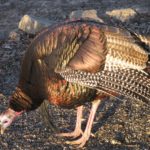
-
Cook Wild turkey differently than domesticated ones.
-

-
Maple syrup can sweeten many Thanksgiving meals.
by Winding Pathways | Sep 19, 2019 | (Sub)Urban Homesteading, Foraging, Nature, Trees
Delicious, Erratic Acorns
Our back deck at Winding Pathways is an outstanding vantage point for watching butterflies, birds, and even our evening aerialist bats. The deck is perched over a deep, cool ravine with a stately black oak hovering above. That can be a problem.
In most autumns our black oak cascades acorns down to the ground and our deck. Removing them takes aggressive sweeping. Despite the hassle we love acorns.
Acorns are, of course, the seeds of oak trees. Hundreds of oak species live across much of the northern hemisphere. They can be a little tricky to identify since oaks sometimes hybridize and look like a blend of two or more species. Many people use leaf shape to identify trees, but oaks may throw a curve. Often leaves, called sun leaves, up on the top of an individual tree are smaller and may have a somewhat different shape than those down lower on the same tree. It can be confusing.
There are two general oak types, the white and red oak groups. White oak type trees include species commonly called white, swamp white bur (sometimes spelled burr), chinkapin also spelled chinquapin, and chestnut oaks. Their leaves have rounded lobes and they produce large acorns with low acid content. Red oak type trees include species commonly called red, black, and pin oaks. Their leaves have pointed lobes and their acorns are usually small and laden with bitter acid.
-
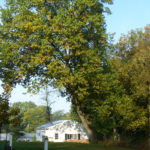
-
Acorns from the black Oak are small and bitter.
-
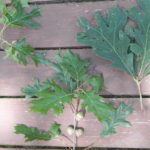
-
Oaks have different shaped leaves
-
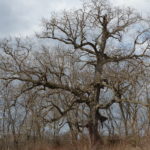
-
Century Oak Tree
-
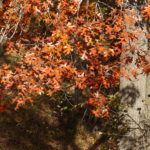
-
Oak leaves turn russet in autumn.
Acorns
Acorns are nature’s gift to many wildlife species and people. Few seeds are as abundant, large, and nutritious as acorns. Squirrels, chipmunks, muskrats, woodchucks, deer, bears, blue jays, wild turkeys, and a host of other animals gorge on them. The calorie-rich nuts help wildlife put on fat that helps them survive the coming winter.
But, there’s a problem. Oaks are erratic acorn producers. As a general rule, the white oak types only create a heavy crop every few years. Red oak type trees are more reliable but still sometimes skip a year of seed production. Sometimes few oaks in a vast area will produce acorns while an individual tree here and there will be loaded. Find a heavy acorn bearer in a scare year and you’ll have the company of many animals feeding on the nutritious nuts. Part of the reason for erratic crops stems from pollination. Oaks are wind-pollinated and a long spell of rain when they bloom in the spring can dampen pollination and eliminate a crop that autumn.
-
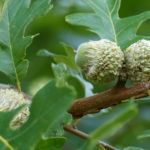
-
Acorns set up in the spring
-
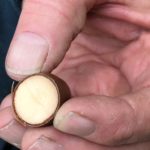
-
The white meat of an acorn.
-
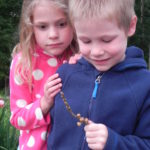
-
Two kids check out the acorns on a branch
-
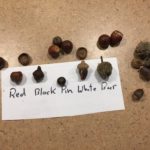
-
Iowa has many types of oaks
Acorns are a delicious human food that was relished by native people across the globe. To learn more about acorns and how to process them into food check out the Winding Pathways blog of August 2014 called Delicious Acorns.
by Winding Pathways | Jun 13, 2019 | Foraging, Weeds
Every summer we enjoy dining on Swiss chard and spinach, but one of our favorite greens to come from the garden is lamb’s quarters. It’s a plant with many common names that is ready to pick and eat before chard or spinach mature. Some call the plant pigweed but that name is also used for other species. Lamb’s quarters remain edible through the summer as long as only tender young leaves are plucked.
Lamb’s quarters is a “no work” green. We never plant, cultivate, or water it. It’s not necessary. It’s a weed that plants itself and pops up in the garden and on the edge of the lawn. We only have to pick, wash, cook, and eat it.
What IS Lamb’s Quarters?
This amazing garden and yard weed grows almost everywhere in the United States and probably lives near just about every person. A usually disliked garden chore is pulling or hoeing weeds. Often those weeds are just discarded or composted. It’s ironic that often those weeds are tastier and more nutritious than the crop being weeded. Lamb’s quarters is one of the best and easiest of the edible weeds.
Lamb’s quarters is an erect branched plant with leaves that shed water. Sprinkle a few drops on the plant and they’ll either bead up or run off, leaving the leaf dry. Try it!
How Do You Process Lamb’s Quarters?
We pick a small pot full of young lamb’s quarter leaves and stems, rinse them well, and steam or boil them for about ten minutes. They are delicious when topped with a dab of butter or a bit of oil and vinegar. Lamb’s quarters cook down significantly, so a pot full of raw leaves will yield only a small amount of cooked vegetables. Pick plenty. If the plant is allowed to mature the tiny seeds are also edible and nutritious but processing them is beyond tedious. Lamb’s quarter leaves can also sparingly be used raw in salads.
-
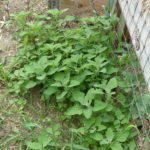
-
Lamb’s Quarters readily grow in disturbed soil.
-
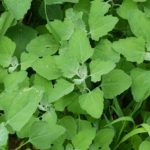
-
The silvery leaf sheds water.
-
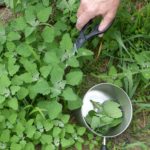
-
A full pot of raw Lamb’s Quarters cooks down to a few fork fulls of this nutritious potherb.
Caveat!
Before eating a new wild plant make sure you have correctly identified it from at least two reputable sources, such as wild edible books, the Internet, or a skilled foraging mentor. Then only eat a small amount the first time. Occasionally a plant may be delicious and harmless to most people but allergic to a few.
Use Identification Sources
Our favorite sources for wild edible information are the classic Stalking the Wild Asparagus book by Euell Gibbons and A Field Guide to Edible Wild Plants by Lee Peterson. Many websites also feature this plant. A helpful website is Edible Wild Food.
by Marion Patterson | May 9, 2019 | (Sub)Urban Homesteading, Bugs, Foraging, Garden/Yard, Nature, Uncategorized
A delightful swatch of color flitted by as we sat on our back deck on one of spring’s first warm sunny days. It was a red admiral butterfly that landed on a post just a few feet from us. It appeared to be enjoying the weather as much as we were.
We’ve since spotted many red admirals in the yard, probably because stinging nettles thrive on the north end of our property. It’s the favored plant for red admiral caterpillars, although they’ll also live on other types of nettles. That poses somewhat of a dilemma.
What is a Red Admiral Butterfly?
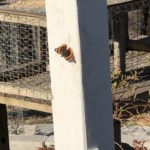
These colorful butterflies depend on early blooming plants like nettles.
Red Admirals are a common butterfly across much of the temperate globe. They’re found across Europe and Asia, North Africa, Hawaii, and much of North America, especially the eastern half of our continent. The larvae feed on stinging nettles, which may not be native. So, if red admirals need stinging nettles what did they eat before the plant was introduced to North America in the early days of European exploration? It’s not even certain that stinging nettles are exotic. They may have been here all along, or early butterflies may have fed on wood nettles.
We appreciate both the insect and plant here at Winding Pathways. Red admirals add color and movement to the yard, while nettles make delicious eating. It’s the first wild green we harvest each early spring.
Can You Eat Nettles?

Carefully pluck the top three leaves off.
Stinging nettles are ready to harvest early – about the time when chard, spinach, and lettuce are planted. When the nettles are just a few inches tall we pluck off the top three or four leaves. They are called stinging nettles because the plant has tiny hairlike stingers. Walk through a patch in summer wearing shorts and nettles cause instant pain. But it’s temporary and not dangerous. Another name for the plant is the “seven-minute itch.” The sting comes from histamines.
We gather young nettles without getting stung by carefully plucking just the top leaves between our thumb and forefinger and snapping them off. About 100 young nettle tops make two servings. We bring them into the kitchen, rinse them a couple of times, and steam them for just a minute or two. The sting disappears and resulting greens are delicious. Plus they pack a nutritious array of vitamins and are high in protein.
Nettle season is short. By the time the plants are eight or ten inches tall, the new leaves are getting tough. But by then we’re harvesting chard and spinach from the garden.
We’re happy to share our yard with both red admirals and nettles. Anyone with a partly shady yard with damp soil might want to start a nettle patch. Wear a pair of gloves and dig up a few and plant them in the yard. They aren’t fussy and will provide excellent table fare and a higher likelihood that the yard will be home to the colorful butterfly.
by Winding Pathways | May 24, 2018 | (Sub)Urban Homesteading, Flowers/Grasses, Foraging, Garden/Yard, Garden/Yard, Weeds
Years ago, a homeowner visited a garden store and bought plugs of a plant commercially called ground ivy, but most folks today call it Creeping Charlie.
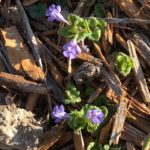
A great ground cover that can get away from you.
In many ways this exotic plant was an ideal ground cover. It’s tough, easy to transport and plant, adaptable to a wide range of conditions, needs no special care, and it spreads like crazy. It only grows a few inches tall so was touted as a plant that, once established, needs no maintenance. And, it attracts valuable pollinators early in the season before other flowering blooms appear.
Benefits
Creeping Charlie’s benefits are also its curse. It does everything too well. Creeping Charlie doesn’t creep. Rather, it races to cover a yard with astonishing speed, often crowding out more desirable plants.
There are two ways to view Creeping Charlie.
It’s either a pernicious pest or a friend that needs little care. At Winding Pathways, we look at it both ways depending on where it’s growing. When it’s crowding wildflowers or our garden vegetables we rip it out of the ground. In places where it can’t infect a garden or native wildflowers we leave it be and know we won’t need to mow that area often.
Controlling Creeping Charlie
There are lots of ways to control Creeping Charlie. We pull it out of the ground. Roundup and other herbicides kill it, and it’s possible to smother it under black plastic sheeting. Mulch works for a while but soon the plant will thrive on even a thick layer of shredded wood mulch.
A member of the mint family and also known more romantically by an elderly Irish friend as “Gill-Over-the-Ground”, Creeping Charlie is also edible steamed, added to omelets or brewed as a tea.
Other Ground Covers
We prefer ground covers that are less aggressive than Creeping Charlie. One of our favorites is the native Pussy Toes, which grows in patches in our lawn. We planted some when we moved in eight years ago and because we don’t put herbicides on our lawn it is spreading nicely. It is hardy and thrives in dry, sandy soil in baking sun. The hairy, silvery leaves lie close the ground and in spring send up enchanting stems with little “pussy toe” flowers. The Lady Bird Wildflower Center confirms this native plant is widely spread and thrives in open meadows and woodlands and rocky areas. We’ve seen it all over the eastern half of the country and Canada. We love it! Again, it saves mowing, adds color and texture to the landscape and attracts early season pollinators.
We also use Vinca, with its periwinkle flowers, on some parts of our lawn especially areas we do not want to mow. It spreads easily, adds color and texture to the landscape and reduces maintenance.
-
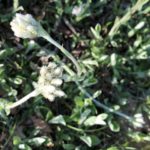
-
Pollinators like ants flock to pussytoes.
-
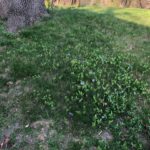
-
An excellent ground cover.
-
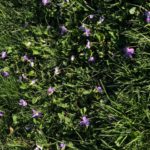
-
Pretty purple violets.
Our lawn actually is a mosaic of many plants. Since we shun herbicides we have a lawn blend of grasses, violets, dandelions, pussytoes, and many other plants. They are all fascinating and help pollinators through the seasons.





















